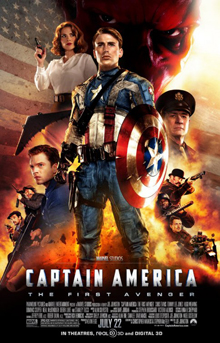
Firstly in act 1 we have the exposition, in Captain America: The First Avenger this is when we meet Steve, a weak and fairly scrawny guy, and we see him getting beat up but not giving in until his friend comes along to help him. We then follow him and find that Steve wants to join the war efforts but isn't allowed to due to his many health issues. Next we have the incident, this is when Steve meets Dr Erskine and is told he can join the army provided he takes part in an experiment. In plot point 1, after Steve is injected with Erskine's serum, Steve chases down a spy that is trying to steal the serum. This is where Steve first meets someone working for the main antagonist.
In act 2 Steve faces obstacles such as the way he is entertainment for the masses instead of being the soldier he aimed to be, this is something he becomes aware of when he has to provide entertainment for a regiment of soldiers and they mock him. It is then that he finds out his friend, Bucky, is missing as he is meant to be in that regiment. This leads to the first culmination as that is where Steve stops being entertainment and instead goes and saves Bucky, finding the antagonist, Red-skull's, plans. The mid point is then when Steve and Bucky return and begin to rally a group for a mission to stop Red-skulls plans. The next plot point, Plot point 2, is when Steve discovers that there is a bomb in the plane and its headed for the centre of the city.
This leads into the climax which occurs at the very end of Act 2, near the beginning of Act 3. This is when Steve realises the choice he must make and crashes the plane into the ocean, thus saving everyone.
In Act 3 the twist and the resolution are closely ties as the twist is when we find out that Steve is actually still alive, preserved in the ice, and the resolution is then when they are de-icing him.




























